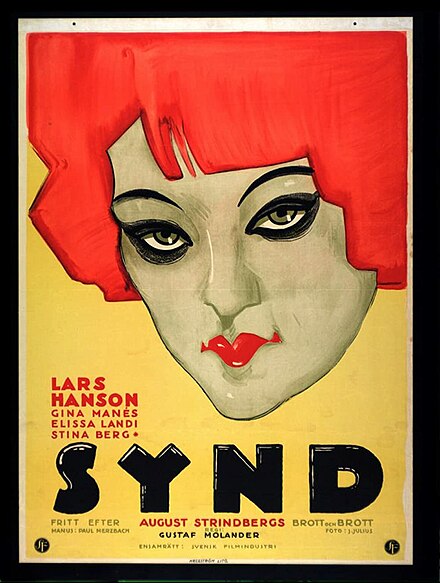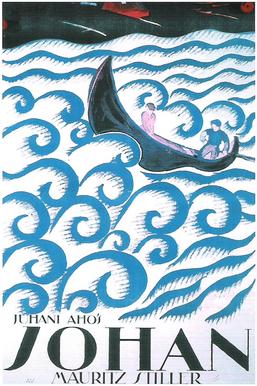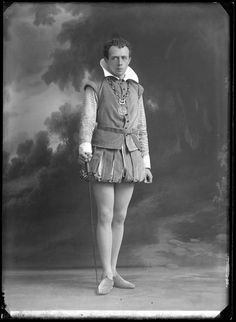
Scott Lord on the Silent Film of Greta Garbo, Mauritz Stiller, Victor Sjostrom as Victor Seastrom, John Brunius, Gustaf Molander - the Golden Age of Swedish Silent Film........Lost Films in Found Magazines, among them Victor Seastrom directing John Gilbert and Lon Chaney, the printed word offering clues to deteriorated celluloid, extratextual discourse illustrating how novels were adapted to the screen; the photoplay as a literature;how it was reviewed, audience reception perhaps actor to actor.
Saturday, April 12, 2025
The Photoplay: Swedish Silent Movie Posters
Swedish Silent FilmSwedish Silent Film
Swedish Silent Film
Swedish Silent Film
Swedish Silent Film
Swedish Silent Film
Gustaf MolanderSwedish Silent Film
Gustaf Molander
swedish silent film
Swedish Silent Film
Mauritz Stiller
Mauritz Stiller
Mauritz Stiller
Lars Hanson
Maurtitz Stiller
John Brunius
Swedish Silent Film Stars on the Theater Stage
Gustaf Molander
Gustaf Molander had in fact been at the Intima Teatern from 1911-13. Gustaf Molander
Karen Molander
Actress Karin Molander appeared with the Intima Teatern between 1911-1920 while married to Swedish Silent Film screenwriter and director Gustaf Molander. She began filming under the direction of Victor Sjostrom during 1914.
Swedish Silent Film Stars Swedish Silent Film Stars
Swedish Silent Film Stars on the Theater Stage
Einar Froberg
Einar Froberg acted at the Svenska Teatern during 1903. Froberg co-starred with Victor Sjostrom in the 1913 film "Barnet", directed by Mauritz Stiller. He returned to the screen in front of the camera in 1924 in a photoplay which he had scripted for Swedish Silent Film director Sigurd Wallen in the film "Grevarna pa Svenska".Erik Petschler
Erik Petschler acted at the Djurgardsteatern during 1912.Friday, April 11, 2025
Scott Lord Silent Film: Black Oxen (Frank Lloyd, 1924)
Claimed to have been a "sensation" by writers of the period, "Black Oxen" (eight reels) was directed by Frank Lloyd, who co-wrote the script with Mary O'Hara as an adaptation of a then recent, then controversial novel by Gertrude Atherton. Atherton took the title from a phrase from poet William Butler Yeats. The film stars actresses Corinne Griffith and Clara Bow.
Screenland magazine reviewed the film during November of 1923. "The passing years are like black oxen, wrote Gertrude Atherton, plodding on relentlessly. The heroine of 'Black Oxen' is a famous beauty who successfully renews her youth, thereby creating a new world for herself, far from her old loves and dreams."
SILENT FILM
SILENT FILM
SILENT FILM
Scott Lord Silent Film: The Craving (John and Francis Ford, 1919)
In the extratextural discourse that may have developed the confections of genre, Motion Picture Weekly published press sheets for Bluebird's "sensational melodrama" "The Craving" with "Suggestions for Putting This Picture Over", their having announced that in some shots of its "remarkable photography" there were "as many as four distinct exposures" that would "make audiences gasp." The film's "Distinctive Feature" was "mysterious illusions of weird beauty."
Silent Film
Silent Film
Scott Lord Silent Film: The Golem, How He Came into the World (Paul Wegener, 1920)
Exhibitor's Herald during 1921 praised the film "The Golem" (Der Golem) for its "ingenious handling of the masses engaged in many of the scenes, persons numbering in the thousands", claiming, "the point of direction and composition" was a "splendid piece of work". It also added, "The lighting, photography and general detail is lacking, and the characters, many of them, are over done in make-up."
Author Lotte H. Eisner, in his volume "The Haunted Screen", explains the contemporaneity of "The Golem", "Paul Wegener always denied having had the intention of making an Expressionist film with his Golem. But that has not stopped people from calling it Expressionist." Seeing the film as an import, or "art film"- an idea particularly important to Scandinavian film companies during that decade almost up to the departure of Charles Magnusson from Swedish Biograph, and therefore an idea frequent in the extratextural film discourse of film critics and reviewers- Picture Play Magazine during 1921 also compared "THe Golem" to "Doctor Caligari" and the theater of Max Reinhardt in its having translated to the screen "the immense imaginative possiblities of the futurist school of dramatic expression". That year periodical highlighted the film with a two page photo dislay, each photo taking up half a page, explaining that "sensational success is predicted" while introducing the "foeign made film", "one of the most important European productions". The photocaptions pointed out the films "curious haunting beauty." The British peridical Pictures and Picturegoer during 1923 did in fact approach genre theory by combining then recent early examples of the mystery thriller, including John Barrymore in his appearance in Dr. Jeckyll and Mr. Hyde, in the article Macabre Movies, distinguishing "The Golem" as a "picturization of a mediaeval legend" but comparing its "Cubist scenery" with that of "Doctor Caligari" with its half-lit ineteriors.
Wegener had given a lecture during 1916 entitled "The Artistic Possibilities of Cinema" as a proponent of "cinematic lyricism" where lines would appear then change as moving surfaces.
Motion Picture World, rather, during 1921 chose to begin with the film's "subject matter" and its "preposteruous story". "He has grasped the most essential fact about his duties as a director- to tell a story in action and develop characters at the same time. Every foot of film advances the progress of the story. There are no cutbacks, no halts for bits of local color or parenthetical description of any of the characters. He knows the meaning of the word drama."
The periodical Motion Picture News during 1921 noted, "Wegener deserves double credit for he also plays the tile role and makes it an unforgettable figure."
Paul Wegener wrote,directed and starred in the his first adaptation of the novel "The Golem" in 1915, presumed to be almost entirely lost with only fragments surviving. Henri Galeen co-wrote and co-directed the photoplay exhibited as "Monster of Fate" in the United States, where Wegener appeared in the 1926 film "The Magician", directed by Rex Ingram.
Silent Film Silent Film Lon Chaney

























